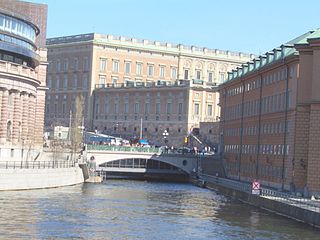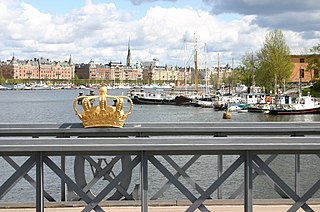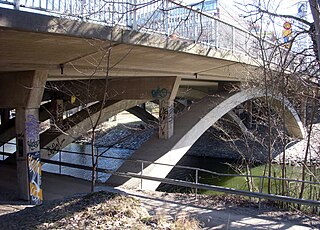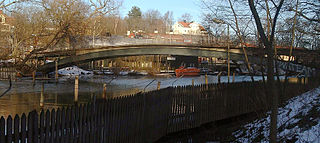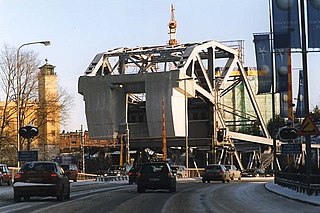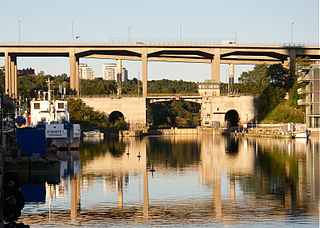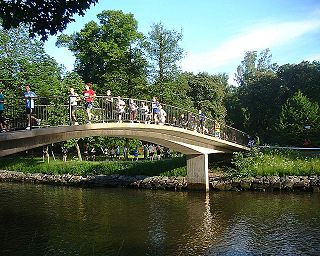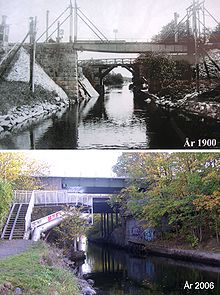
Ålkistan (Swedish: "The Eel Hatch") is the name of a canal, and the surrounding area, north of Stockholm, Sweden. The canal connects Lilla Värtan to Lake Brunnsviken, and delimits Bergshamra, the northern part of Solna, from the northern part of Djurgården.
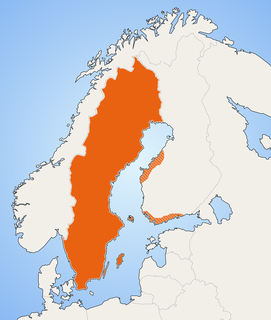
Swedish is a North Germanic language spoken natively by 10 million people, predominantly in Sweden, and in parts of Finland, where it has equal legal standing with Finnish. It is largely mutually intelligible with Norwegian and to some extent with Danish, although the degree of mutual intelligibility is largely dependent on the dialect and accent of the speaker. Both Norwegian and Danish are generally easier for Swedish speakers to read than to listen to because of difference in accent and tone when speaking. Swedish is a descendant of Old Norse, the common language of the Germanic peoples living in Scandinavia during the Viking Era. It has the most speakers of the North Germanic languages.

Canals, or navigations, are human-made channels, or artificial waterways, for water conveyance, or to service water transport vehicles.
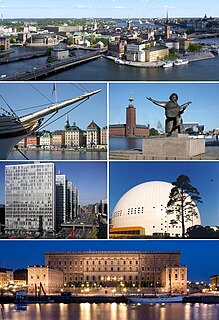
Stockholm is the capital of Sweden and the most populous urban area in the Nordic countries; 960,031 people live in the municipality, approximately 1.5 million in the urban area, and 2.3 million in the metropolitan area. The city stretches across fourteen islands where Lake Mälaren flows into the Baltic Sea. Just outside the city and along the coast is the island chain of the Stockholm archipelago. The area has been settled since the Stone Age, in the 6th millennium BC, and was founded as a city in 1252 by Swedish statesman Birger Jarl. It is also the capital of Stockholm County.
The name Ålkistan first appears on a map of Djurgården dated 1649, pointing out Åhlekijstetorpet ("The Eel Hatch Cottage"), Åhlekijstebackan ("The Eel Hatch Hillside") and Åhlekijste wijken ("The Eel Hatch Bay"). In a rivulet leading to the bay eels were caught using cages (in Swedish called kista, "coffin"), which gave the area its present name. The cottage is mentioned as a tavern in 1789. [1]
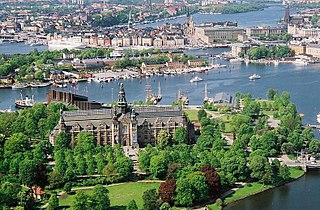
Djurgården or, more officially, Kungliga Djurgården is an island in central Stockholm, Sweden. Djurgården is home to historical buildings and monuments, museums, galleries, the amusement park Gröna Lund, the open-air museum Skansen, the small residential area Djurgårdsstaden, yacht harbours, and extensive stretches of forest and meadows. It is one of the Stockholmers' favorite recreation areas and tourist destinations alike, attracting over 10 million visitors per year, of which some 5 million come to visit the museums and amusement park. The island belongs to the National City park founded in 1995. Since the 15th century the Swedish monarch has owned or held the right of disposition of Royal Djurgården. Today, this right is exercised by the Royal Djurgården Administration which is a part of the Royal Court of Sweden.

An eel is any ray-finned fish belonging to the order Anguilliformes, which consists of four suborders, 20 families, 111 genera, and about 800 species. Eels undergo considerable development from the early larval stage to the eventual adult stage, and most are predators. The term “eel” originally referred to the European eel, and the name of the order means “European eel-shaped.”

A tavern is a place of business where people gather to drink alcoholic beverages and be served food, and in most cases, where travelers receive lodging. An inn is a tavern that has a license to put up guests as lodgers. The word derives from the Latin taberna whose original meaning was a shed, workshop, stall, or pub.
By the mid-19th century, mud threatened to cork the rivulet, which would effectively have turned Lake Brunnsviken, being used as refuse dump as it was, into a sewer. King Charles XV therefore ordered the present canal to be constructed in 1863, which lowered the water level of Brunnsviken by two metres. A 6.5-metre-wide (21 ft) wooden bridge with a mobile flap leading over the canal was added at the same time. The bridge was substituted in 1937 by a 23-metre-wide (75 ft) bridge with an 18-metre-wide (59 ft) roadway and a horizontal clearance of 8 metres, rebuilt in 1972. [1] [2]

Charles XV & IV also Carl ; Swedish: Karl XV and Norwegian: Karl IV was King of Sweden and Norway from 1859 until his death. Though known as King Charles XV in Sweden, he was actually the ninth Swedish king by that name, as his predecessor Charles IX had adopted a numeral according to a fictitious history of Sweden.
There was a railway stop at Ålkistan from 1885 until 1923, at the Roslag Railway. [3] The railway is still operational, but the trains do not stop at Ålkistan anymore.

Roslagsbanan is a narrow gauge urban railway system in Roslagen, Stockholm County, Sweden. Its combined route length is 65 kilometres and there are 38 stations. It is built to the Swedish three foot gauge.
As of 2007 [update] , no ships wider than 4.0 metres or deeper than 1.6 metres are allowed in the canal. Next to Ålkistan is a residential area, Sfären ("The Sphere"), with a local centre. [4]

